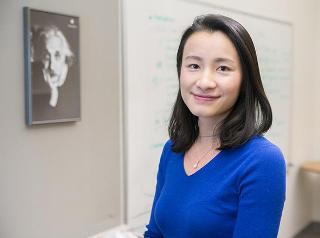Nov 14 2014
One of the problems in the high-tech field of visible light communication (VLC) - or using light to send data wirelessly - is decidedly low tech: The data transmission stops whenever the light is blocked by people's movements, shadows or other obstacles.
 This is Xia Zhou, an assistant professor in Dartmouth College's Department of Computer Science. (Credit: Dartmouth College)
This is Xia Zhou, an assistant professor in Dartmouth College's Department of Computer Science. (Credit: Dartmouth College)
But Dartmouth researchers are experimenting with the first "smart spaces" that feature an interplay of algorithms, ceiling-mounted LEDs, or light-emitting diodes, and light sensors embedded in floors and in smart devices. Such smart spaces track users' gestures and separate shadows from light, enabling a continuous flow of data wirelessly not only between personal computers but smart devices in rooms, buildings, trains and other indoor places. The integrated visible light communication project, or iVLC, is the first time an integrated networking and sensing environment has been proposed for sending information by light.
"We imagine that all future indoor spaces will take advantage of the ubiquity of lights as a medium that integrates communication and passive sensing," says Xia Zhou, the project's principal investigator and an assistant professor of computer science who is co-director of the DartNets (Dartmouth Networking and Ubiquitous Systems) Lab. "VLC has been around for some time and is gaining momentum, but existing efforts have mostly come from the electrical engineering side and focused on a single VLC link. They design better modulation schemes or LED luminaire to achieve higher data rate or boost link reliability. Little has been studied on VLC's practical systems and networking problems and new applications. My research aims to bridge this gap and pursues key problems from a computer science perspective. Essentially, we are asking: Given this cool physical layer technology, what would it take to make it the next big thing? What are the practical challenges if we use an array of these VLC links to provide always-on network connectivity? What are the new applications that VLC can enable and problems that VLC can uniquely help solve?"
Researchers worldwide are refining wireless technologies that use light rather than radio waves to transmit high-speed data - in other words, using the light shining around you to control digital information at the flick of a switch. VLC technologies change the intensity and frequency of LEDs to manipulate optical signals and send large amounts of data rapidly, economically and safely in a way that is imperceptible to the human eye. In recent years, VLC research has focused on using clusters of LEDs in ceilings and receivers in computers, but transmissions can be stopped simply by blocking the light, a challenge that is further complicated by the growing types of smart devices.
"Mobile computing is accelerating beyond the smartphone era," Zhou says. "Today, people wear smart glasses, smart watches and fitness devices and carry smartphones, tablets and laptops. In a decade, the same people are likely to wear or carry tens of wireless devices and interact with the Internet and computing infrastructure in markedly different ways."
Two fundamental challenges emerge in a post-smartphone era: dealing with the impending radio spectrum crunch before it becomes a full-fledged crisis, and advancing human-computer interaction before people buckle under the demands of dealing with an ever increasing number of personal devices.
Dartmouth researchers recently received a $500,000 National Science Foundation grant to address these challenges. Their iVLC project designs integrated networking and sensing for smart spaces and a set of robust VLC networking and sensing algorithms. The networking algorithms address the following challenges: 1) frequent connection disruptions caused by user movements and the limited coverage of individual VLC links, 2) link interference from diffusive lights, and 3) determining the optimal placement and density of LED lights.
Addressing these challenges requires efficient handoff schemes between adjacent LEDs, interference handling schemes for VLC networks and optimization algorithms to determine the LED light deployment in smart spaces. The VLC sensing requires accurate inference of user movements using shadows rendered on the floor, but the combination of light from multiple light sources on the ceiling distorts these shadows.
To tackle this challenge, the iVLC system separates shadow components by embedding identifiers into light signals from LEDs, allowing light sensors on the floor to measure individual light sources. In other words, the system uses shadows to identify user gestures and track movements seamlessly, creating an uninterrupted flow of data. Preliminary results from simulation tests are promising, and the Dartmouth researchers are currently working on a proof-of-concept iVLC testbed using LEDs and light sensors.
Zhou's related research includes:
- A recent $230,000 NSF grant in collaboration with researchers at UCSB to identify malfunctioning wireless devices and unauthorized transmitters on the radio spectrum. The goal is to reduce the cost of enforcement of network rules by adding the capability of some smartphones to sense the radio spectrum use and report back to a central database.
- HiLight, a new form of screen-camera communication, which opens opportunities for new human-computer interactions and context-aware applications to emerge, such as smart-glass communicates with screens for additional personalized information to realize augmented reality. This work has been awarded the Best Paper Award at the 1st ACM Workshop on Visible Light Communication Systems.